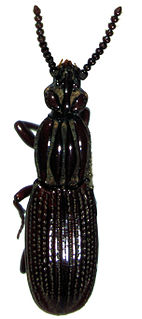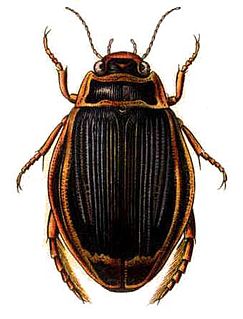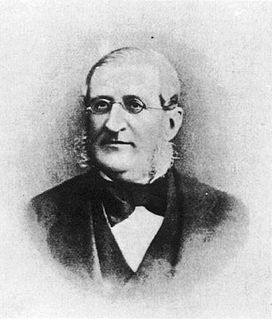
Ground beetles are a large, cosmopolitan family of beetles, Carabidae, with more than 40,000 species worldwide, around 2,000 of which are found in North America and 2,700 in Europe. It is one of the ten most speciose animal families, as of 2015.

Rhysodidae is a family of beetles, consisting of more than 350 species in about 20 genera.

The Adephaga, with more than 40,000 recorded species in 10 families, are a suborder of highly specialized beetles and the second-largest suborder of the order Coleoptera. Members of this suborder are adephagans, a term which notably include ground beetles, tiger beetles, predacious diving beetles, and whirligig beetles. The majority of the species belongs to the family of carabids, or ground beetles (Carabidae).
Walther Hermann Richard Horn was a German entomologist who specialised in beetles (Coleoptera). He was born in Berlin, where he also died. He is not to be confused with the American entomologist George Henry Horn, another entomologist that studied Coleoptera.

Maximilien Chaudoir, or Maximilien, baron de Chaudoir, was a Russian entomologist. He was a specialist in Coleoptera and in particular the Carabidae. His Cicindelidae are conserved by the Muséum national d'histoire naturelle in Paris. His Carabidae were acquired by Charles Oberthür (1845-1924), then given to the same museum. He wrote Mémoire sur la famille des Carabiques, 6 volumes commencing 1848.

Zabrus is a genus of ground beetles. They are, unusually for ground beetles, omnivores or even herbivores, and Zabrus tenebrioides can become a pest in cereal fields.

Calosoma is a genus of large ground beetles that occur primarily throughout the Northern Hemisphere, and are referred to as caterpillar hunters or searchers. Many of the 167 species are largely or entirely black, but some have bright metallic coloration. They produce a foul-smelling spray from glands near the tip of the abdomen. They are recognizable due to their large thorax, which is almost the size of their abdomen and much wider than their head.

Nebria is a genus of ground beetles native to the Palearctic, the Near East and North Africa.

Clivina is a genus of ground beetle native to the Palearctic, the Nearctic, the Near East and North Africa. There are at least 580 described species in Clivina.

Chlaenius is a large and diverse genus of ground beetle. It is native to the Palearctic, the Near East, North Africa, Afrotropical region, and the Nearctic. Worldwide, roughly 1,000 species are currently recognized with the majority of known species occurring in the Oriental and Afrotropical regions. The genus is divided into many subgenera.

Anthiinae is a subfamily of beetles in the family Carabidae, containing the following genera:
Brachininae is a subfamily of beetles in the family Carabidae, containing the following genera:

Carabinae is a subfamily of beetles in the family Carabidae, containing the following genera:

Nebriinae is a subfamily of beetles in the family Carabidae, containing the following genera:

Orthogoniinae is a subfamily of ground beetles. Occasionally it was treated as a tribe Orthogoniini of subfamily Harpalinae, particularly when this was circumscribed loosely.
Psydrinae is a subfamily of beetles in the family Carabidae.

Pterostichinae is a subfamily of ground beetles. It belongs to the advanced harpaline assemblage, and if these are circumscribed sensu lato as a single subfamily, Pterostichinae are downranked to a tribe Pterostichini. However, as the former Pterostichitae supertribe of the Harpalinae as loosely circumscribed does seem to constitute a lineage rather distinct from Harpalus, its core group is here considered to be the present subfamily and the Harpalinae are defined more narrowly.
Rhysodinae is a subfamily of wrinkled bark beetles in the family Carabidae. The group of genera making up Rhysodinae has been treated as the family Rhysodidae in the past, and DNA analysis has more recently supported treating it as the tribe Rhysodini.

Omoglymmius is a genus of wrinkled bark beetles in the family Carabidae, found on every continent except Africa and Antarctica. There are at least 150 species in Omoglymmius.

Elaphropus is a genus of ground beetles in the family Carabidae. There are at least 370 described species in Elaphropus.
















